Paper Menu >>
Journal Menu >>
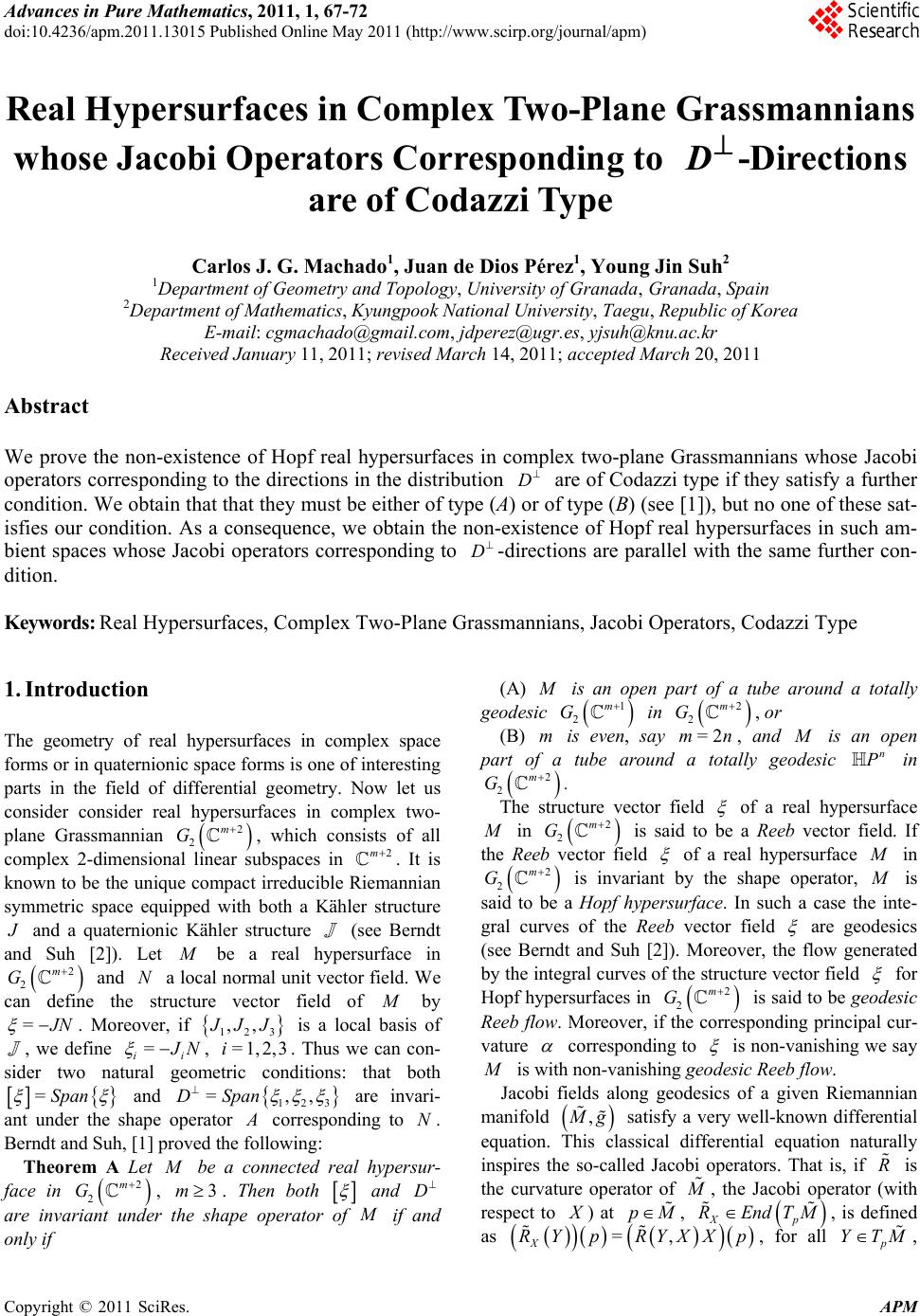 Advances in Pure Mathematics, 2011, 1, 67-72 doi:10.4236/apm.2011.13015 Published Online May 2011 (http://www.scirp.org/journal/apm) Copyright © 2011 SciRes. APM Real Hypersurfaces in Complex Two-Plane Grassmannians whose Jacobi Operators Corresponding to D-Directions are of Codazzi Ty pe Carlos J. G. Machado1, Juan de Dios Pérez1, Young Jin Suh2 1Department of Geom etry and Topology, University of Granada, Granada, Spain 2Department of Mat hem at ic s, Kyungpook National U niversi t y , Taegu, Republic of Kore a E-mail: cgmachado@gmail.com, jdperez@ugr.es, yjsuh@knu.ac.kr Received January 11, 2011; revised March 14, 2011; accepted March 20, 2011 Abstract We prove the non-existence of Hopf real hypersurfaces in complex two-plane Grassmannians whose Jacobi operators corresponding to the directions in the distribution D are of Codazzi type if they satisfy a further condition. We obtain that that they must be either of type (A) or of type (B) (see [1]), but no one of these sat- isfies our condition. As a consequence, we obtain the non-existence of Hopf real hypersurfaces in such am- bient spaces whose Jacobi operators corresponding to D -directions are parallel with the same further con- dition. Keywords: Real Hypersurfaces, Complex Two-Plane Grassmannians, Jacobi Operators, Codazzi Type 1. Introduction The geometry of real hypersurfaces in complex space forms or in quaternionic space forms is one of interesting parts in the field of differential geometry. Now let us consider consider real hypersurfaces in complex two- plane Grassmannian 2 2 m G , which consists of all complex 2-dimensional linear subspaces in 2m . It is known to be the unique compact irreducible Riemannian symmetric space equipped with both a Kähler structure J and a quaternionic Kähler structure (see Berndt and Suh [2]). Let M be a real hypersurface in 2 2 m G and N a local normal unit vector field. We can define the structure vector field of M by = J N . Moreover, if 123 ,, J JJ is a local basis of , we define = ii J N , =1,2,3i. Thus we can con- sider two natural geometric conditions: that both =Span and 123 =,,D Span are invari- ant under the shape operator A corresponding to N. Berndt and Suh, [1] proved the following: Theorem A Let M be a connected real hypersur- face in 2 2 m G , 3m. Then both and D are invariant under the shape operator of M if and only if (A) M is an open part of a tube around a totally geodesic 1 2 m G in 2 2 m G , or (B) m is even, say =2mn, and M is an open part of a tube around a totally geodesic n P in 2 2 m G . The structure vector field of a real hypersurface M in 2 2 m G is said to be a Reeb vector field. If the Reeb vector field of a real hypersurface M in 2 2 m G is invariant by the shape operator, M is said to be a Hopf hypersurface. In such a case the inte- gral curves of the Reeb vector field are geodesics (see Berndt and Suh [2]). Moreover, the flow generated by the integral curves of the structure vector field for Hopf hypersurfaces in 2 2 m G is said to be geodesic Reeb flow. Moreover, if the corresponding principal cur- vature corresponding to is non-vanishing we say M is with non-vanishing geodesic Reeb flow. Jacobi fields along geodesics of a given Riemannian manifold , M g satisfy a very well-known differential equation. This classical differential equation naturally inspires the so-called Jacobi operators. That is, if R is the curvature operator of M , the Jacobi operator (with respect to X ) at pM, Xp REndTM , is defined as =, X RY pRYXXp , for all p YTM, 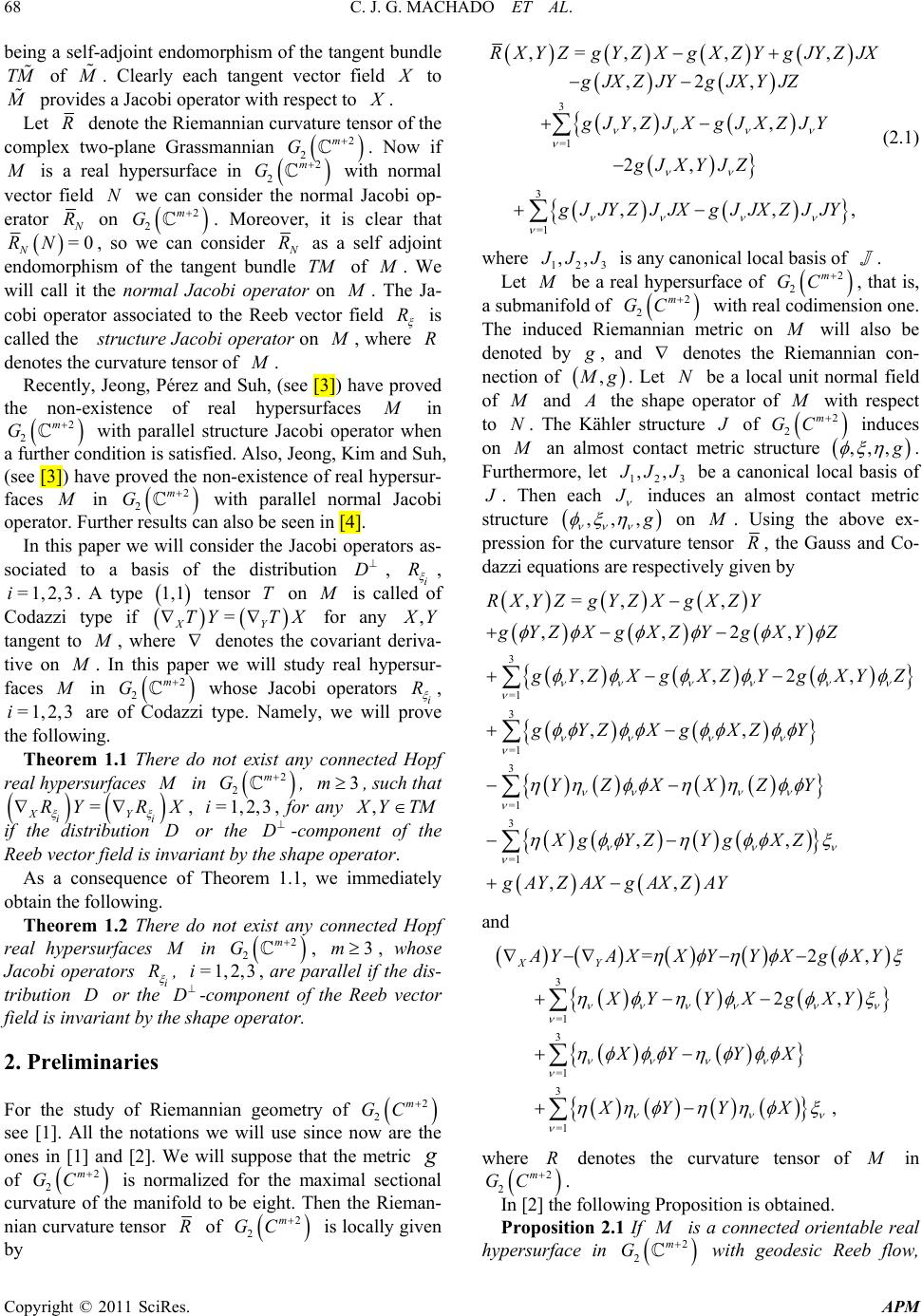 C. J. G. MACHADO ET AL. Copyright © 2011 SciRes. APM 68 being a self-adjoint endomorphism of the tangent bundle TM of M . Clearly each tangent vector field X to M provides a Jacobi operator with respect to X . Let R denote the Riemannian curvature tensor of the complex two-plane Grassmannian 2 2 m G . Now if M is a real hypersurface in 2 2 m G with normal vector field N we can consider the normal Jacobi op- erator N R on 2 2 m G . Moreover, it is clear that =0 N RN , so we can consider N R as a self adjoint endomorphism of the tangent bundle TM of M . We will call it the normal Jacobi operator on M . The Ja- cobi operator associated to the Reeb vector field R is called the structure Jacobi operator on M , where R denotes the curvature tensor of M . Recently, Jeong, Pérez and Suh, (see [3]) have proved the non-existence of real hypersurfaces M in 2 2 m G with parallel structure Jacobi operator when a further condition is satisfied. Also, Jeong, Kim and Suh, (see [3]) have proved the non-existence of real hypersur- faces M in 2 2 m G with parallel normal Jacobi operator. Further results can also be seen in [4]. In this paper we will consider the Jacobi operators as- sociated to a basis of the distribution D , i R , =1,2,3i. A type 1,1 tensor T on M is called of Codazzi type if = XY TY TX for any , X Y tangent to M , where denotes the covariant deriva- tive on M . In this paper we will study real hypersur- faces M in 2 2 m G whose Jacobi operators i R , =1,2,3 i are of Codazzi type. Namely, we will prove the following. Theorem 1.1 There do not exist any connected Hopf real hypersurfaces M in 2 2 m G , 3m, such that = XY ii RY RX , =1,2,3i, for any , X YTM if the distribution D or the D-component of the Reeb vector field is invariant by the shape operator. As a consequence of Theorem 1.1, we immediately obtain the following. Theorem 1.2 There do not exist any connected Hopf real hypersurfaces M in 2 2 m G , 3m, whose Jacobi operators i R , =1,2,3i, are parallel if the dis- tribution D or the D-component of the Reeb vector field is invariant by the shape operator. 2. Preliminaries For the study of Riemannian geometry of 2 2 m GC see [1]. All the notations we will use since now are the ones in [1] and [2]. We will suppose that the metric g of 2 2 m GC is normalized for the maximal sectional curvature of the manifold to be eight. Then the Rieman- nian curvature tensor R of 2 2 m GC is locally given by 3 =1 3 =1 ,=, ,, ,2, ,, 2, ,,, RXYZgYZX gXZY gJYZJX gJXZJY gJXYJZ gJYZJXgJXZJY gJXYJZ gJ JY ZJ JXgJ JXZJ JY (2.1) where 123 ,, J JJ is any canonical local basis of . Let M be a real hypersurface of 2 2 m GC , that is, a submanifold of 2 2 m GC with real codimension one. The induced Riemannian metric on M will also be denoted by g , and denotes the Riemannian con- nection of , M g. Let N be a local unit normal field of M and A the shape operator of M with respect to N. The Kähler structure J of 2 2 m GC induces on M an almost contact metric structure ,,, g . Furthermore, let 123 ,, J JJ be a canonical local basis of J . Then each J induces an almost contact metric structure ,,, g on M . Using the above ex- pression for the curvature tensor R, the Gauss and Co- dazzi equations are respectively given by 3 =1 3 =1 3 =1 3 =1 ,=, , ,,2, ,,2, ,, ,, ,, RXYZgYZXgXZY gYZ XgXZYgXY Z g YZXgXZYgXYZ gYZ XgXZY YZXXZY Xg YZYgXZ gAYZAXgAXZAY and 3 =1 3 =1 3 =1 =2, 2, , XY A YAXXYYXgXY XYYX gXY XY YX XYYX where R denotes the curvature tensor of M in 2 2 m GC . In [2] the following Proposition is obtained. Proposition 2.1 If M is a connected orientable real hypersurface in 2 2 m G with geodesic Reeb flow, 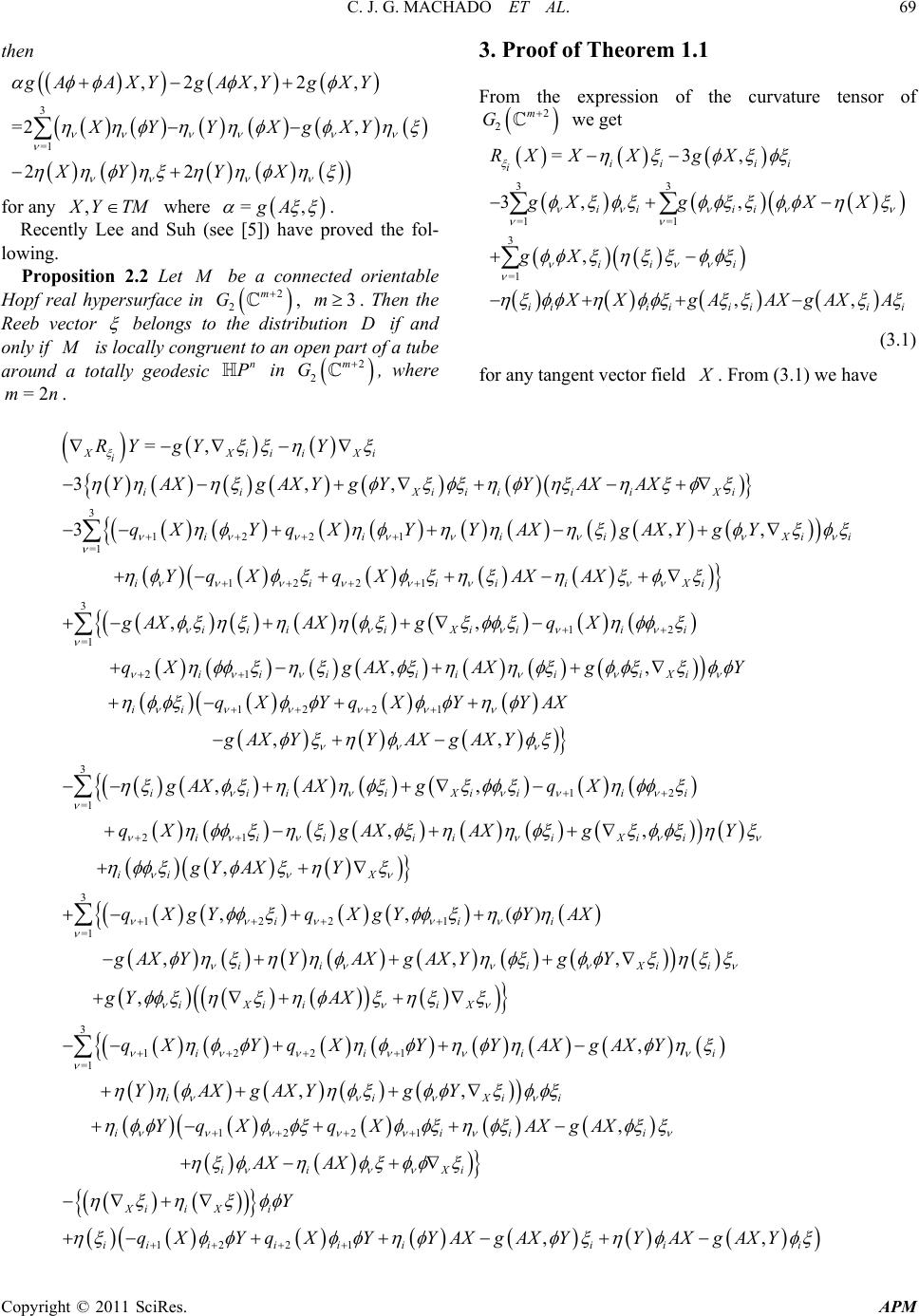 C. J. G. MACHADO ET AL. Copyright © 2011 SciRes. APM 69 then 3 =1 ,2,2 , =2 , 22 gAAXY gAXY gXY XYY XgXY XY YX for any , X YTM where =,gA . Recently Lee and Suh (see [5]) have proved the fol- lowing. Proposition 2.2 Let M be a connected orientable Hopf real hypersurface in 2 2 m G , 3m. Then the Reeb vector belongs to the distribution D if and only if M is locally co ng ru en t to an open part o f a tu b e around a totally geodesic n P in 2 2 m G , where =2mn. 3. Proof of Theorem 1.1 From the expression of the curvature tensor of 2 2 m G we get 33 =1 =1 3 =1 =3, 3, , , ,, ii ii i ii ii ii i iiiiiii i RX XXgX gXgXX gX X XgAAXgAXA (3.1) for any tangent vector field X . From (3.1) we have 3 1221 =1 1221 3 =1 =, 3,, 3,, XXiiiXi i iiXiiiiiXi iiii Xii iiiiiXi RY gYY YAXgAX YgYYAXAX qXYqXYY AXgAXYgY YqXqXAX AX g 12 21 12 21 3 =1 ,, ,, ,, ,, iiiiXi iii ii iiiiiXi ii iii iXi AXAXgq X qXgAX AXgY qXYqX YYAX gAX YYAXgAXY gAXAX g 12 21 3 1221 =1 ,, , ,,() ,,, , iii ii iiii Xii ii X iii iii Xii i qX qXgAX AXgY gY AXY qXgYqXgYYAX gAXYYAXgAXYgY gY 3 1221 =1 12 21 , ,, , Xiii X iii i iiXii iiii ii Xi Xii Xi AX qXYqXYY AXgAXY YAXgAXYgY YqX qXAXgAX AX AX 12 21,, ii iiiiiii Y qXYqX YYAXgAXYYAXgAXY 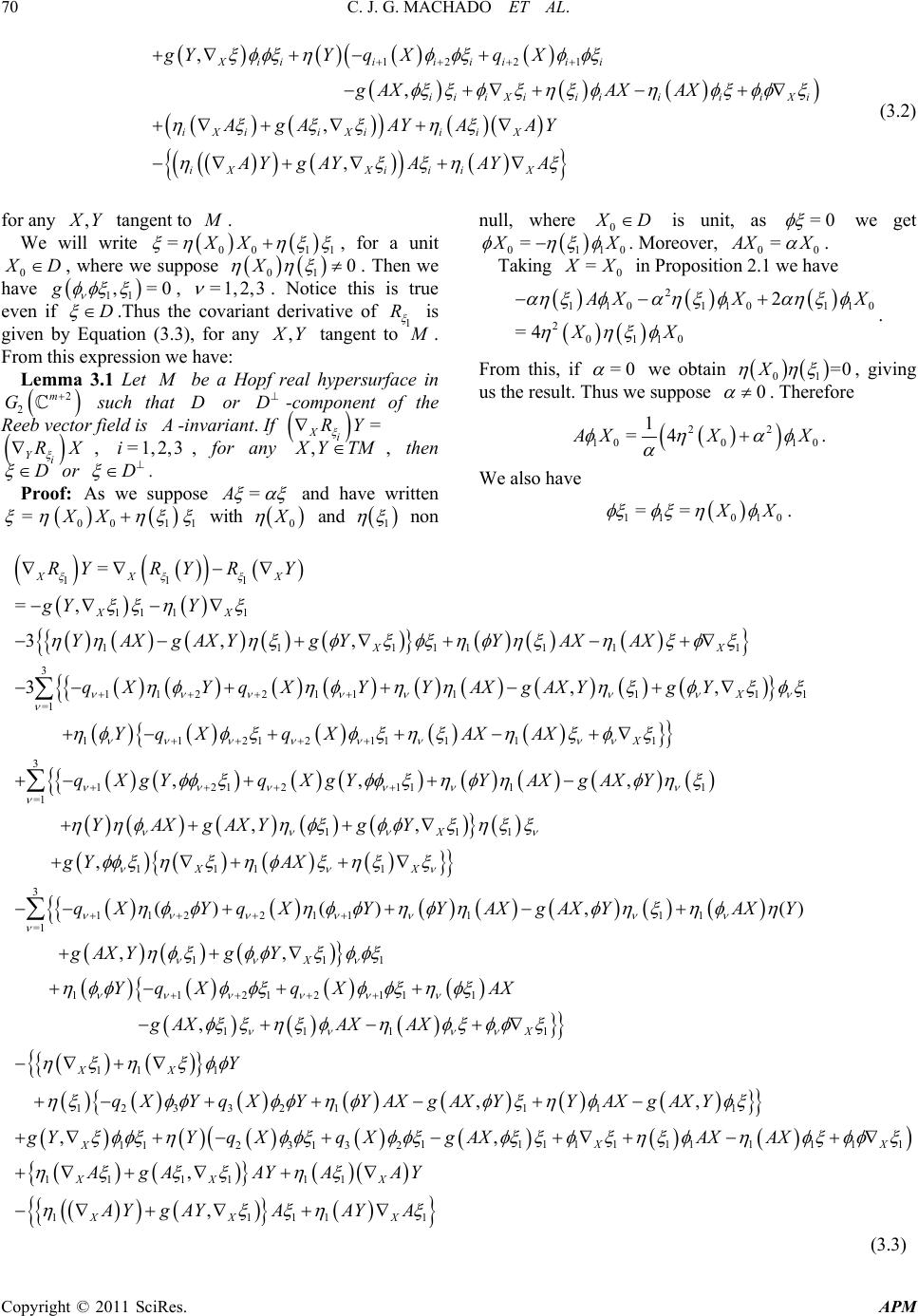 C. J. G. MACHADO ET AL. Copyright © 2011 SciRes. APM 70 12 21 , , , , Xiiiiiiii iiiXiiiiii Xi iXiiXiii X iXXi iiX gYYq XqX gAXAX AX AgAAY AAY AYgAYAAYA (3.2) for any , X Y tangent to M . We will write 00 11 =XX , for a unit 0 X D, where we suppose 01 0X . Then we have 11 ,=0g , =1,2,3 . Notice this is true even if D .Thus the covariant derivative of 1 R is given by Equation (3.3), for any , X Y tangent to M . From this expression we have: Lemma 3.1 Let M be a Hopf real hypersurface in 2 2 m G such that D or D-component of the Reeb vector field is A -invariant. If = Xi RY Yi RX , =1,2,3i, for any , X YTM, then D or D . Proof: As we suppose =A and have written 00 11 =XX with 0 X and 1 non null, where 0 X D is unit, as =0 we get 0110 = X X . Moreover, 00 = A XX . Taking 0 = X X in Proposition 2.1 we have 2 110110110 2 0110 2 =4 A XXX XX . From this, if =0 we obtain 01 =0X , giving us the result. Thus we suppose 0 . Therefore 22 10010 1 =4 A XXX . We also have 11 010 == X X . 111 11 11 11111111 3 112 2111111 =1 112121111 = =, 3,, 3,, XX X XX XX X RYRY RY gY Y YAXgAX YgYYAXAX qXYqXYY AXgAXYgY YqXqXAX AX 1 3 12121111 =1 111 111 1 3 112 211111 =1 ,, , ,, , () (),() X X XX qXgYqXgYYAXgAXY YAXgAXY gY gY AX qXYqXYY AXgAXYAXY g 111 11212111 11 11 11 1 12 33 21111 112 313 2 ,, , ,, , X X XX X AX YgY YqX qXAX gAXAX AX Y qXYqXYYAXgAXYYAXgAXY gYYq Xq X 11111111111 11 1111 11111 , , , XX XX X XX X gAXAX AX AgAAY AAY AYgAYAAYA (3.3)  C. J. G. MACHADO ET AL. Copyright © 2011 SciRes. APM 71 From (3.3) we get 2 1100 0 1 32 001 ,= 7. g RXX X XX (3.4) and 10 0 11 23 01 0 ,=4 44. g RX X XX (3.5) As we suppose that 1 R is of Codazzi type (3.4) and (3.5) must be equal. This yields 2 0=0X . As we suppose 0 the result follows. □ With the hypothesis in Lemma 3.1, we can prove: Lemma 3.2 If D then ,0gADD Proof: In this case, we can take 1 = . Thus the condition of 1 R being of Codazzi type is equivalent to R also being. Taking =Y and X D we get 32 231 =2 2. XRAXA AXAX AX AX (3.6) On the other hand =.RXAX AX (3.7) Therefore we have 32231 22 = A XA AXAXAXAX AXA X Taking its scalar product with 2 it follows 23 22 ,2 =,. gA AXAX AXgA X (3.8) and the scalar product with 3 yields 32 33 ,2 =, gA AXAX AXgA X (3.9) Now the Codazzi equation gives 22 23 ,= , =,. X gAXg A g AAX AX and 33 32 ,= , =, . X gAXg A g AAX AX From (3.8) and (3.9) we get 2 32 2 23 2=0. 2=0. AX AX AX AX (3.10) If =0 we have finished. If 0 , from (3.10) we obtain 2 23 2 = A XAX and 3 A X 2 2 2 = A X . Clearly, this yields 2 A X 3 ==0AX , finishing the proof. □ From this Lemma and Proposition 2.2, in order to fin- ish the proof of our Theorem, we only have to see if the real hypersurfaces of either type A or type B satisfy our condition. In the case of a real hypersurface of type A we get from Proposition 3 in [1], considering 1 = and taking 2 =X , =Y , that if our condition is satisfied we should have 2 2=RR . This yields 2 233 2=0.A As 2=A 3 q we have 33 2=0.q (3.11) From (3.11) we have 30q and 2=0 . If =0 , from the second equality we also obtain =0 , but =2cot 2r for some π 0, 8 r . Thus this is impossible. If = , from the second equality we get 22=0 , having a contradiction. Thus 3=0q . From the second equality we get 2=0 , with =8cot 8r and =2cot 2r for some π 0, 8 r . Then 2 2 = 2cot2= 0r , which is impossible and we can conclude that type A real hy- persurfaces do not satisfy our condition. In the case of a real hypersurface of type B let us suppose it satisfies our condition. From Proposition 2 in [1] it is easy to see that 11 1,=4gR and 2 11 1,=4gR . As both expressions must be equal, we obtain 2 4 =4 , where now =2tan2r and =2cot2r , for some π 0, 4 r . This yields 2 tan2= 2r , which is impossible and the proof concludes. As a conclusion we have obtained that Jacobi opera- tors corresponding to D -directions have the same be- haviour as the normal Jacobi operator and structure Ja- cobi operator if we consider their covariant derivatives in the direction of any tangent vector field are null. In order to continue this research it is interesting to investigate 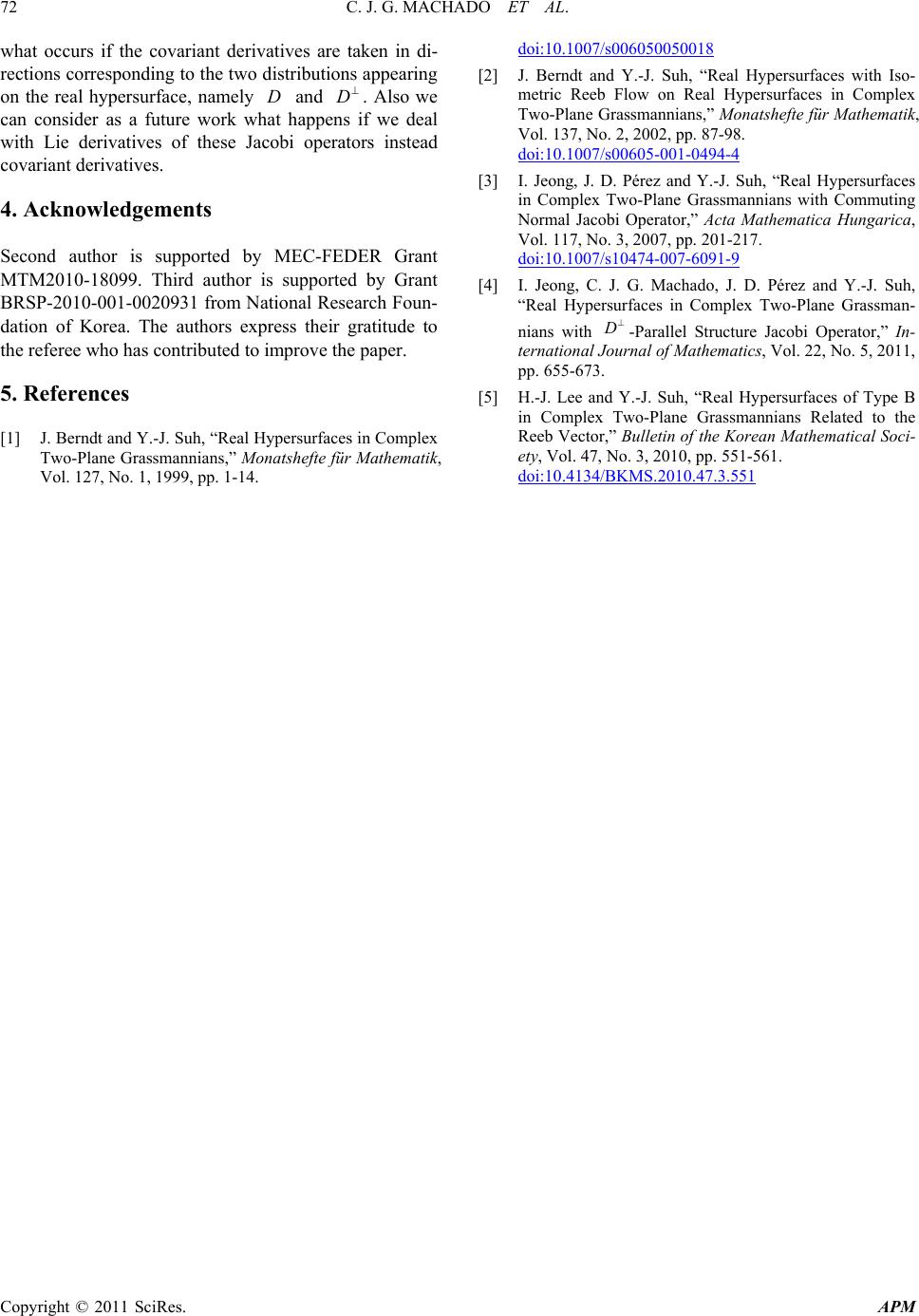 C. J. G. MACHADO ET AL. Copyright © 2011 SciRes. APM 72 what occurs if the covariant derivatives are taken in di- rections corresponding to the two distributions appearing on the real hypersurface, namely D and D. Also we can consider as a future work what happens if we deal with Lie derivatives of these Jacobi operators instead covariant derivatives. 4. Acknowledgements Second author is supported by MEC-FEDER Grant MTM2010-18099. Third author is supported by Grant BRSP-2010-001-0020931 from National Research Foun- dation of Korea. The authors express their gratitude to the referee who has contributed to improve the paper. 5. References [1] J. Berndt and Y.-J. Suh, “Real Hypersurfaces in Complex Two-Plane Grassmannians,” Monatshefte für Mathematik, Vol. 127, No. 1, 1999, pp. 1-14. doi:10.1007/s006050050018 [2] J. Berndt and Y.-J. Suh, “Real Hypersurfaces with Iso- metric Reeb Flow on Real Hypersurfaces in Complex Two-Plane Grassmannians,” Monatshefte für Mathematik, Vol. 137, No. 2, 2002, pp. 87-98. doi:10.1007/s00605-001-0494-4 [3] I. Jeong, J. D. Pérez and Y.-J. Suh, “Real Hypersurfaces in Complex Two-Plane Grassmannians with Commuting Normal Jacobi Operator,” Acta Mathematica Hungarica, Vol. 117, No. 3, 2007, pp. 201-217. doi:10.1007/s10474-007-6091-9 [4] I. Jeong, C. J. G. Machado, J. D. Pérez and Y.-J. Suh, “Real Hypersurfaces in Complex Two-Plane Grassman- nians with D -Parallel Structure Jacobi Operator,” In- ternational Journal of Mathematics, Vol. 22, No. 5, 2011, pp. 655-673. [5] H.-J. Lee and Y.-J. Suh, “Real Hypersurfaces of Type B in Complex Two-Plane Grassmannians Related to the Reeb Vector,” Bulletin of the Korean Mathematical Soci- ety, Vol. 47, No. 3, 2010, pp. 551-561. doi:10.4134/BKMS.2010.47.3.551 |

